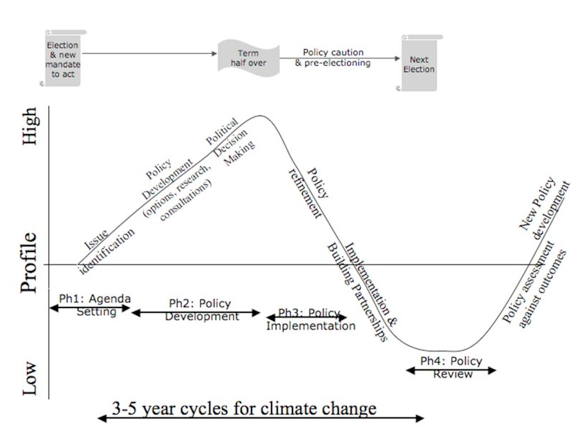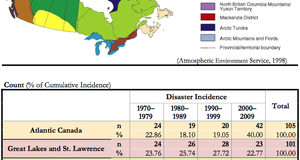From Earth Common Journal VOL. 3 NO. 1Climate Change Strategies 101
IN THIS ARTICLE
KEYWORDS
AbstractThe development of climate change action plans and strategies is usually done via the policy cycle during the first half of a government’s term. This short- term political process is at odds with the longer-term climate change issue that requires a consistent and sustained effort. Consequently, this often leads to conflicting and ever changing climate plans and strategies that often do not fully move to implementation. Several key strategic questions need to be considered at the policy agenda setting stage. Examples of these questions include: the real impetus for developing the plan, political will to take on policy development at a particular time, the degree of intention to actually implement it, and depth of target versus costs to the economy. The developmental stage of climate plans in Canada has historically involved five key components (with many variations): 1) background policy and scientific work; 2) consultation process; 3) economic/policy analysis and target setting; 4) building political support for a greenhouse gas target and policy package to meet the target; and 5) refinement and final political approval. Businesses are also responding by developing climate change strategies to either hedge their risk of being regulated, hedge their risk related to severe weather events, and/or to take advantage of climate business opportunities. IntroductionGovernments around the world broadly accept the scientific conclusion that through the burning of fossil fuels and land clearing, humans are warming the planet and changing the climate. While the public perception may be that the scientific community is deeply divided on this question, the reality is that the vast majority of climate change papers (97%) published since 1991 support this conclusion (Cook et al., 2013). Further, most governments have been developing climate change strategies and action plans to respond to this growing issue. A climate change strategy or plan is essentially a government’s policy intention to undertake a suite of actions to reduce greenhouse gas (GHG) emissions and/or to adapt to the changing climate. In Canada at least, this represents an official policy position of a government currently in power, but is generally not legally binding or enforceable. It can be compared to releasing a blueprint for a house you intend to build, but does not commit you to actually hiring a contractor. The terms “climate strategy” and “climate plan” or “climate action plan” are often used synonymously. However, some jurisdictions do apply a more rigorous definitional approach in which a strategy sets out broad goals (as GHG reduction targets) policy outcomes and measures, while an action plan tends to contain more specifics. It seems probable that some climate strategies/plans are more “green washing” and that the promoting government may never implement them. Where there exists a real intent to take action, more detailed implementation plans, legislation, regulations, incentive programs or other mechanisms that will attempt to deliver the strategies’ goals and outcomes usually follow the climate strategies. For example, Canada has had a series of climate strategies and action plans, goals and targets that were introduced by several governments (and at least two political parties) but none were fully implemented (NRTEE, 2012). Businesses develop climate change strategies to either hedge their risk of being regulated, hedge their risk related to related severe weather events, and/or to take advantage of climate business opportunities. This paper outlines the role climate change strategies play for both government and businesses. Government: Climate strategies and political cyclesClimate change is a long-term decadal issue, while western-style democracies are short-term (2-4 year). Rising GHG emissions are tightly linked to energy use and development, with our current heavy reliance on fossil fuels as the root cause of climate change (IPCC, 2007). Hofmeister (2010) has argued that this timing mismatch between long-term energy use and development, resulting climate changes, and the political process is part of our fundamental problem in not making progress on these intertwined issues. Figure 1 illustrates how the election cycle overlaps with the policy cycle. Figure 1. The political and policy cycles of climate change (Macdonald, 2011)
Bold new policy initiatives generally need to take place before the term of office is half over as this is generally thought to be a high-risk venture by politicians. In the second half of the elected term, politicians tend to shift to pre-electioneering and are averse to taking on any new high-risk policy or fiscal actions that may affect their electability. This second half of the term tends to be the time wherein new climate change policies that have been approved and announced can move to implementation – a politically quiet activity. However, this raises the question …how can you review the performance or effectiveness of a policy in the limited time frame of the political cycle? The results of strong policy may not be evident for years beyond the normal political cycle. Additionally, the policy review phase is often hammered by GHG data that is often two or more years out of date. This makes it difficult for policy makers to assess whether or not progress is being made. For relatively stable governments, who tend to stay in power for long periods of time (such as the People’s Republic of China or the conservative-dominated government in the province of Alberta, Canada) this does not pose a great problem. However, most democracies have a great deal of political turnover. This can lead to constantly changing climate policy positions and strategies with few policy actions moving to implementation and consequently, little progress being made in reducing GHG emissions. The United States is a case in point; Democrat administrations try to put climate change and environmental policies in place while Republican administrations usually attempt to roll them back. Government: Agenda Setting - Key Strategic QuestionsA number of key strategic questions need to be addressed at the Agenda Setting phase of the policy cycle (Figure 1), before a government becomes committed to the development of a climate strategy. These questions include:
Following is a discussion of these questions. 1. What is the real political motivation for putting this plan together? The political motivation for developing a climate change strategy can be varied and include: 1) genuine risk mitigation based on firm convictions (e.g. the EU); 2) optics – appear to be doing something with weak or no real intention of implementing the action plan (e.g. the U.S. during the George W. Bush administration, or Canada during the Harper administration to be seen to be “doing our part,” 3) transitioning to a more sustainable/greener economy and realizing the economic benefits of transitioning (e.g. Iceland), and 4) setting a good example for others to follow – convince other countries to act (e.g. Tuvalu, Costa Rica). While the answers to this question almost never appear in the final climate plan, they become crucially important in securing political support for the plan internal to the government. 2. How much political will or capital is there to take on this issue at this particular time? Again, the answer to this question usually becomes apparent as the policy development phase unfolds. Weak political support will usually translate into an equally weak plan and the converse is true for strong political support. Political will to act on climate change is a function of a number of signals that politicians are hearing: 1)how climate change ranks as a priority and the potential link to other policy issues the government is facing; 2) how strong is national/international pressure (including pressure from major trading partners) to act on climate change; 3) how the public/voters and opposition parties feel about this issue (public opinion polls) and how hard they are pressing the government for action; 4) how aggressively environmental groups and the scientific community are pressing government and how successful they are in shaping public policy; 5) what politicians themselves believe about this issue; and 6) fossil fuel industry pressure to protect their interests by limiting policy actions. 3. As a government, how aggressive a GHG reduction target you are willing to take on versus how much economic “pain” you can justify to voters? These two interrelated questions need to be considered hand-in-hand and also link to the aforementioned political will question. The deeper the GHG reductions desired, the greater political will is needed because of the greater economic impact. 4. Which is the priority – mitigation (reducing GHG emissions) or adapting to the impacts of climate change? For most developed countries mitigation is more important, but for most developing countries impacts and adaptation is the priority. Most climate plans end up with a unique country circumstance blend of mitigation and impacts/adaptation. This blend is reflected in the final climate plan. For example, Canadian and European plans tend to be heavy on mitigation policies and light on impacts and adaptation, while African country plans tend to be almost exclusively focused on impacts and adaptation and obtaining western financial support to fund adaptation measures. 5. Is this the second or third variation on a jurisdiction’s climate plan and how successful were the previous attempts? At the end of one policy cycle government should undertake a formal review to determine efficacy (Figure 1). What worked? What didn’t? Is it time to tighten the greenhouse gas targets? Many government auditors are increasingly scrutinizing the value for taxpayer spending on delivering climate policies compared to the actual results achieved. For example, in the province of Alberta, the Auditor General has critiqued the government’s climate change strategy and pointed out shortcomings (Alberta Auditor General, 2011). Similarly, the Auditor General in the province of British Columbia has also commented on shortcomings of the government’s attempt to be carbon neutral (Auditor General of B.C., 2013).Continued on Next Page » Suggested Reading from Inquiries Journal
Inquiries Journal provides undergraduate and graduate students around the world a platform for the wide dissemination of academic work over a range of core disciplines. Representing the work of students from hundreds of institutions around the globe, Inquiries Journal's large database of academic articles is completely free. Learn more | Blog | Submit Latest in Environmental Studies |


















